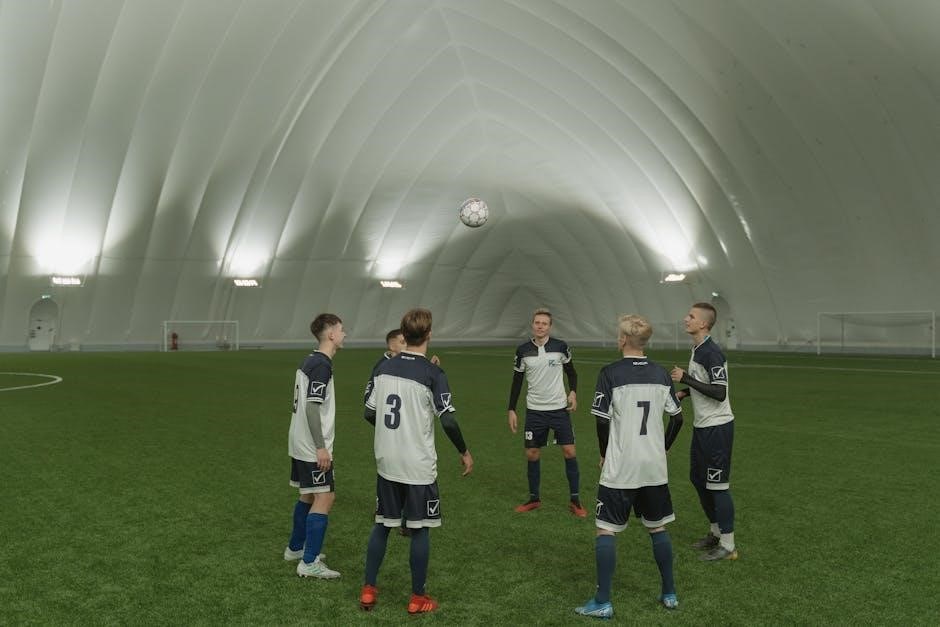soccer practice drills pdf
Discover the ultimate guide to improving soccer skills with structured practice drills. This comprehensive PDF offers detailed exercises, from warm-ups to advanced techniques, ensuring effective skill development for players of all levels.
Overview of Soccer Practice Drills
Soccer practice drills are structured activities designed to enhance player skills, teamwork, and game readiness. These drills cover essential areas like dribbling, passing, shooting, and defense, catering to all skill levels and ages. From basic cone exercises to advanced game-like scenarios, they provide a progressive approach to skill development. Drills are often categorized into warm-ups, technical exercises, and competitive games, ensuring a balanced and engaging training experience. Coaches can adapt these drills to match player abilities, fostering improvement and fun while preparing teams for real-game situations.
Importance of Structured Practice Plans
Structured practice plans are vital for maximizing player development and efficiency. They provide clear objectives, ensuring each session focuses on specific skills and progression. By organizing drills logically, coaches can address technical, tactical, and physical aspects of the game. These plans also allow for adaptability, enabling adjustments based on player feedback and skill levels. A well-structured approach ensures a balanced mix of individual and team activities, fostering a dynamic and productive training environment that prepares players for game scenarios while maintaining engagement and enjoyment.
Benefits of Using PDF Guides for Soccer Drills
PDF guides for soccer drills offer a comprehensive and accessible way to enhance player development. They provide structured, easy-to-follow plans that cover technical, tactical, and physical skills. Coaches can quickly organize practices, ensuring efficient use of time. These guides are versatile, catering to various skill levels and game scenarios. PDF formats are convenient for digital access, allowing coaches to adapt drills based on team needs. They also serve as valuable resources for players seeking to improve independently, making them essential tools for effective soccer training.
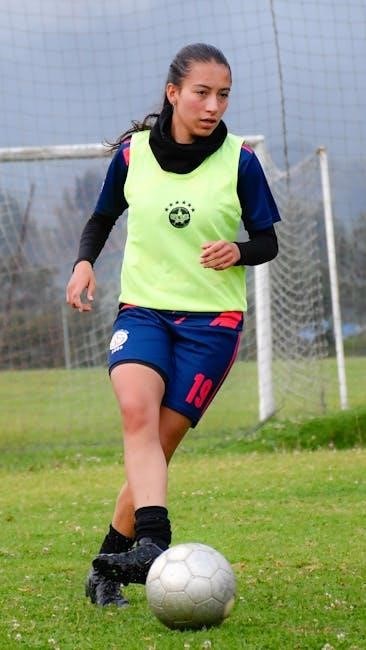
Warm-Up and Basic Drills
A proper warm-up is essential to prepare players for practice, reducing injury risks and enhancing performance. Dynamic stretches and light cardio set the foundation for effective training.
Dynamic Stretching and Light Cardio
Begin with dynamic stretching to prepare muscles for action, focusing on high knees, leg swings, and arm circles. Light cardio, such as jogging or jumping jacks, increases heart rates and loosens muscles. Incorporate soccer-specific movements, like dribbling through cones, to transition smoothly into drills. End with static stretches for flexibility. Keep the warm-up engaging by adding interactive games like soccer tennis to maintain focus and enthusiasm, ensuring players are ready for the practice ahead.
Cone Dribbling Exercises
Cone dribbling exercises enhance ball control and agility. Set up cones in straight lines, zig-zag patterns, or circles. Players weave through cones using different parts of their feet, focusing on precision and speed. Start with slow, controlled movements, then gradually increase difficulty by adding variations like cone arrangements or using both feet. Regular practice builds confidence and mastery in tight spaces, preparing players for game-like scenarios where quick changes of direction and precise control are essential.
Figure-8 Dribbling Patterns
Figure-8 dribbling exercises refine ball control and precision. Set up cones in a figure-8 pattern, and players navigate the ball through the course, alternating feet and maintaining close contact. This drill enhances agility, balance, and the ability to dribble in tight spaces. Encourage players to focus on quick changes of direction and smooth transitions. Gradually increase speed as skill improves, ensuring mastery of both feet. This exercise is ideal for developing confidence and composure in possession, preparing players for game-like scenarios where precise control is crucial.
Zig-Zag Dribbling Patterns
Zig-zag dribbling patterns are excellent for improving ball control and agility. Set up cones in a zig-zag formation, and players weave through them using different parts of their foot. This drill challenges players to maintain possession while changing direction quickly. Encourage small, precise touches and balanced movement. Gradually increase the speed and complexity of the course as players gain confidence. This exercise is ideal for developing the ability to navigate tight spaces and maintain control under pressure during games, enhancing overall dribbling proficiency and composure in competitive situations.
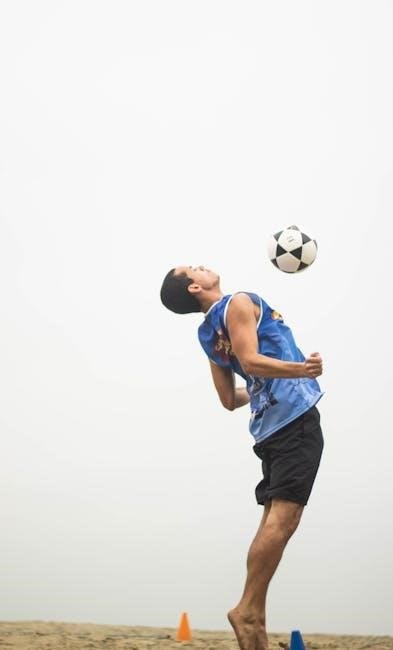
Dribbling and Ball Control Drills
Master essential dribbling skills with drills designed to improve precision, agility, and confidence. These exercises focus on ball control, footwork, and navigating tight spaces effectively during games.
Shielding the Ball
Shielding the ball is a vital skill for maintaining possession under pressure. Players practice using their body to protect the ball while controlling it with their feet. In pairs, one player shields while the other applies gentle pressure. Emphasize proper body positioning, using the inside of the foot, and keeping the ball close. This drill improves balance, strength, and the ability to retain possession in tight spaces. Gradually increase intensity to simulate game-like scenarios, ensuring players can shield effectively while moving, enhancing their confidence and composure during matches.
Center of Town Dribbling Drill
The Center of Town Dribbling Drill focuses on improving ball control and agility in tight spaces. Players dribble through a central area marked by cones, navigating around others while maintaining possession. This exercise enhances close-ball control, quick decision-making, and spatial awareness. Encourage players to use different parts of their feet and vary their speed. Gradually add defenders or obstacles to increase difficulty, simulating game-like scenarios. Regular practice builds confidence and composure, preparing players for competitive situations where precise dribbling is essential.
Musical Balls Dribbling Game
The Musical Balls Dribbling Game is a fun and engaging drill that combines ball control with music. Players dribble a ball to the rhythm of music, focusing on maintaining close control and precision. When the music stops, players must quickly stop their ball or perform a specific move, such as a step-over or drag-back. This drill enhances dribbling technique, reaction time, and concentration. It also adds an element of fun, keeping players motivated and engaged while improving their skills in a dynamic and interactive way.
Passing and Receiving Drills
Master the art of precise passing and confident receiving with these drills. Improve accuracy, field awareness, and teamwork through structured exercises designed to enhance technical and tactical skills.
Short-Rage Passing Exercises
Enhance accuracy and rhythm with short-range passing drills. Players form small grids or lines, passing the ball in sequences while maintaining movement. Begin with stationary passes, then progress to moving scenarios, emphasizing ball control and quick decision-making. Incorporate turns and one-touch passes to simulate game-like situations. These drills improve first-touch quality, spatial awareness, and teamwork, ensuring smooth transitions during matches. Coaches can add pressure or time constraints to elevate the challenge and prepare players for competitive play.
Long-Range Passing Accuracy
Improve field vision and strength with long-range passing drills. Set up two 33-yard squares, 15 yards apart, each player starting with a ball. Begin with a pass and control sequence, gradually increasing pass length and distance. Players alternate roles to practice both sending and receiving. Incorporate movement to simulate game-like scenarios, ensuring proper technique and focus. This drill enhances field vision, strength, and teamwork, essential for effective long ball strategies in competitive play. Coaches can modify setups to suit different skill levels, ensuring engagement and skill development.
Passing and Moving Drills
Enhance teamwork and coordination with drills that focus on passing while maintaining constant motion. Players work in pairs or small groups, emphasizing accurate one-touch passes and quick decision-making. Incorporate cone setups or directional commands to simulate game-like scenarios. As players advance, add defenders to increase pressure, encouraging sharper movements and precise ball control. These exercises ensure smooth transitions and effective communication, preparing teams for dynamic match situations. Coaches can adapt drills to suit different skill levels, ensuring engagement and skill development.
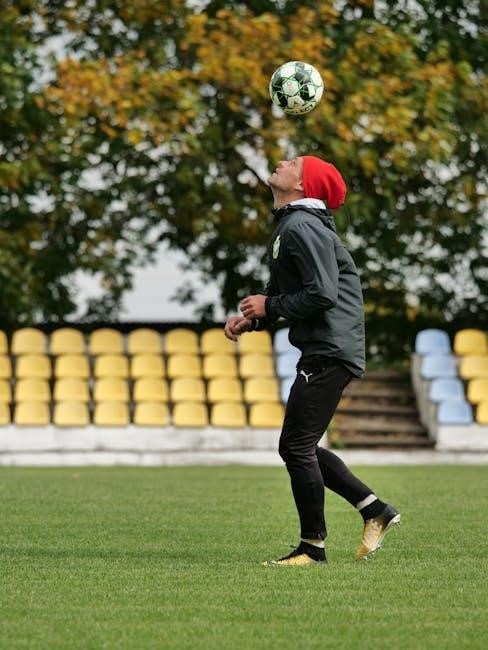
Shooting and Finishing Drills
Master shooting techniques with drills that enhance accuracy and composure under pressure. Improve precision with exercises like Pressure Shots and Knock Down the Flags, simulating game-like scenarios.
Pressure Shots
Pressure Shots simulate game-like intensity, helping players refine their shooting technique under defensive pressure. Set up cones or markers to create shooting lanes at varying angles. Players approach the ball from different directions, focusing on quick decision-making and accurate strikes. A goalkeeper or defender applies pressure to mimic real-game scenarios. Emphasize proper ball striking, body positioning, and follow-through. This drill enhances composure, shooting technique, and the ability to perform under stress, making it ideal for intermediate to advanced players seeking to refine their finishing skills.
Knock Down the Flags
Knock Down the Flags enhances shooting accuracy by targeting small flags or cones placed at varying angles and distances. Players take turns shooting from different spots, aiming to knock down specific flags. The setup includes a series of flags arranged in a zig-zag or circular pattern. Emphasize proper ball striking, body alignment, and follow-through. Gradually increase difficulty by moving flags farther away or adding movement before the shot. This exercise builds confidence and precision, simulating game situations where accurate shooting is crucial for scoring opportunities. Track progress to motivate improvement and competition among players.
Shoulder to Shoulder Shooting
Shoulder to Shoulder Shooting is designed for young players to build confidence and accuracy in front of the goal. Set up small cones or flags as targets, and have players shoot from varying angles. Focus on proper ball striking and body positioning, encouraging controlled shots over power. Gradually add movement or light defensive pressure to increase difficulty. This drill is ideal for U6 to U10 players, fostering composure and precision in scoring situations. Maintain a positive atmosphere to boost confidence and passion for the game.
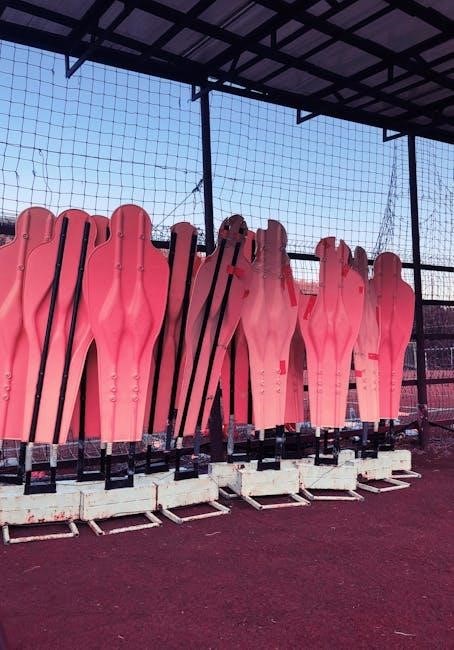
Defensive Drills
Master defensive techniques with drills focused on positioning, tackling, and teamwork. These exercises simulate game-like scenarios, helping players anticipate opponents’ moves and protect the goal effectively.
1v1 Defensive Positioning
Improve defensive instincts with 1v1 drills, focusing on anticipation and reaction. Players practice proper stance, balance, and timing in confined spaces. A coach or teammate attempts to dribble past the defender, who must maintain positioning and protect the goal. Progress by adding game-like scenarios, such as limited dribbling options or passive attackers. This drill enhances defensive confidence, reaction time, and the ability to contain opponents effectively in one-on-one situations, preparing players for real-game challenges.
2v1 Defensive Scenarios
Enhance defensive teamwork with 2v1 scenarios, simulating game-like challenges. Defenders practice coordinating to protect the goal against an attacker. This drill focuses on communication, positioning, and anticipation. Players learn to anticipate opponents’ moves, close down space, and work together to regain possession. The exercise builds defensive strategies, reaction time, and adaptability. Gradually increase difficulty by adding movement or varying attack angles. This prepares players for real-game defensive challenges, improving their ability to defend effectively in high-pressure situations while maintaining composure and coordination.
Guard the Castle Defensive Drill
Guard the Castle is a dynamic defensive drill that emphasizes teamwork and spatial awareness. Players defend a designated zone, working together to protect their “castle” from opponents. This exercise fosters communication, quick decision-making, and strategic positioning. Attackers attempt to breach the defensive line, challenging the guards to adapt and maintain their structure. Coaches can vary the difficulty by adding more attackers or reducing the defensive zone. This drill builds resilience, reaction time, and the ability to defend cohesively in high-pressure game scenarios, preparing players for real-match defensive challenges.
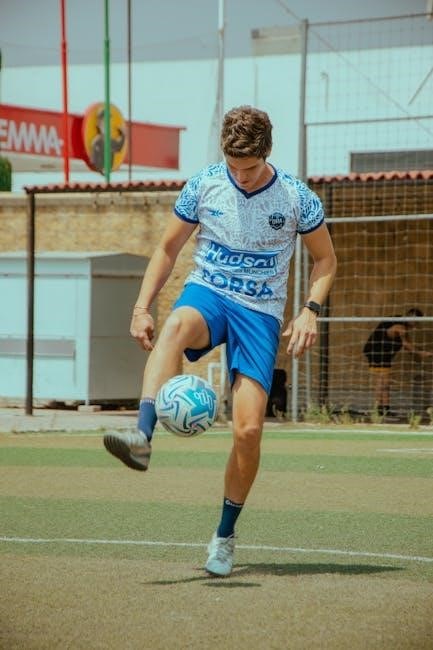
Goalkeeping Drills
Enhance reflexes, footwork, and decision-making with specialized drills for goalkeepers. These exercises simulate game-like scenarios, focusing on breakaway saves, handling, and distribution to build confidence and precision.
Breakaway Saves
Breakaway saves are crucial for goalkeepers to master, as they often determine the outcome of a match. This drill simulates one-on-one situations where a striker attempts to score, and the goalkeeper must react quickly to make a save. Coaches can set up scenarios where the striker approaches from different angles, forcing the goalkeeper to stay low, cut down angles, and use proper diving techniques. Varying the speed and direction of the attack enhances realism. This exercise improves reflexes, decision-making, and confidence in high-pressure situations, ensuring goalkeepers are prepared for critical moments in games.
Handling and Distribution
Handling and distribution are vital skills for goalkeepers, ensuring they can confidently manage the ball and initiate attacks. This drill focuses on improving how goalkeepers catch, throw, and pass the ball accurately. Players strike shots from various angles and distances, simulating game-like scenarios. Goalkeepers practice proper footwork, body positioning, and decision-making to distribute the ball effectively to teammates. Incorporating both short and long passes enhances their ability to start counterattacks. Varying the difficulty by adding pressure from attackers sharpens reflexes and game awareness, making them a reliable last line of defense and a playmaker.
1v1 Goalkeeper Scenarios
1v1 goalkeeper scenarios simulate real-game situations, testing reflexes and decision-making. Goalkeepers face breakaways, prioritizing positioning and footwork to minimize scoring chances. Players attack with speed, forcing goalkeepers to react swiftly, while defenders apply pressure to disrupt. Coaches emphasize proper body positioning, diving techniques, and quick recoveries. This drill enhances a goalkeeper’s ability to read opponents, anticipate moves, and maintain composure under pressure. Regular practice builds confidence and sharpens instincts, ensuring they excel in critical one-on-one defensive moments during matches.
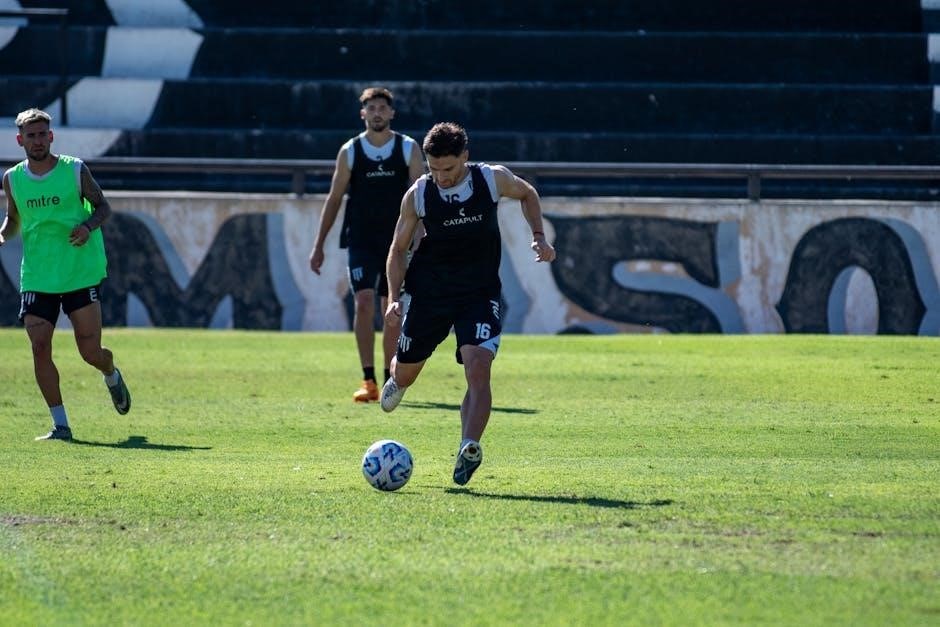
Fitness and Agility Drills
Enhance speed, endurance, and agility with specialized drills. Agility ladder exercises improve footwork, while endurance training builds stamina. Change-of-direction drills simulate game-like explosive movements, boosting overall performance.
Agility Ladder Drills
Agility ladder drills are essential for improving foot speed, balance, and coordination. Players perform high knees, lateral shuffles, and carioca drills through the ladder. These exercises enhance quick directional changes and overall agility. Coaches can vary patterns to challenge players and simulate game-like movements. Proper technique ensures maximum benefit. Progress gradually to more complex drills to build confidence and adaptability. Agility ladder exercises are versatile, making them a cornerstone of soccer training, preparing players for the fast-paced demands of the game.
Endurance and Stamina Building
Endurance and stamina are vital for soccer players to maintain performance over 90 minutes. Drills like interval runs, long-distance jogs, and high-intensity shuttle runs are effective. Incorporate game-specific scenarios, such as repeated sprints and recovery periods, to mimic match demands; Players can also engage in laps around the field or suicides to boost cardiovascular fitness. Ensure adequate rest periods to avoid fatigue. Progressively increase intensity and duration to enhance stamina. Proper hydration and recovery are essential to maximize results and prevent overtraining.
Change of Direction Exercises
Change of direction exercises enhance agility and quick reaction skills, crucial for soccer. Drills like cone weaving, ladder drills, and figure-8 patterns challenge players to shift direction rapidly. Set up cones in zig-zag or circular formations for players to navigate using precise footwork. Incorporate sudden stops, starts, and turns to simulate game-like scenarios. These exercises improve balance, acceleration, and the ability to outmaneuver opponents. Gradually increase speed and complexity to build confidence and mastery in dynamic movements, ensuring players can excel in fast-paced match situations.
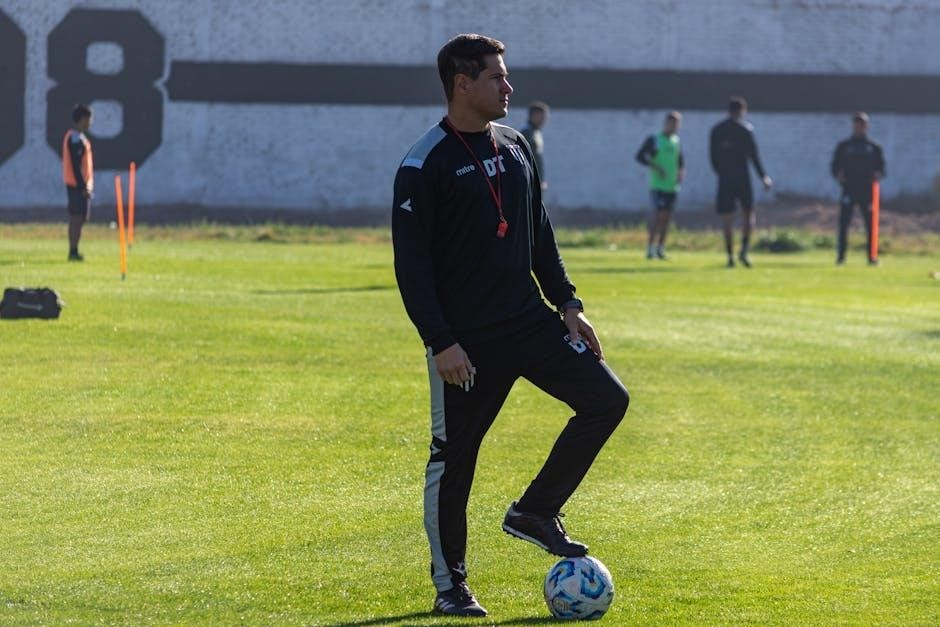
Scrimmage and Game-Like Activities
Engage players with small-sided games and realistic scenarios like 4-on-3 attacks and Space Wars. These drills simulate match conditions, fostering skill application, teamwork, and decision-making under pressure.
Small-Sided Games
Small-sided games, such as 3v3 or 4v4, are essential for simulating real-game scenarios. These drills promote decision-making, teamwork, and skill application in condensed spaces. Players improve ball control, passing accuracy, and spatial awareness while maintaining engagement. Coaches can adapt the size and rules based on skill levels, ensuring a challenging yet fun environment. Incorporating variations like “Space Wars” adds excitement and tests tactical awareness. These games are ideal for developing match-ready skills while fostering teamwork and competitive spirit in a dynamic setting.
4-on-3 Attack Scenarios
4-on-3 attack scenarios create a challenging yet balanced environment for offensive players to develop their decision-making and teamwork. Attacking players focus on quick passes, spatial awareness, and exploiting defensive gaps. Defenders practice communication, positioning, and recovery under pressure. Coaches can modify the field size and rules to suit skill levels, ensuring a productive and engaging drill. This exercise bridges the gap between individual skills and game-like situations, fostering adaptability and creativity in both attackers and defenders during competitive play.
Space Wars Game
Space Wars is an engaging game that simulates tight-space scenarios, fostering creativity and quick decision-making. Players are divided into small groups, competing to maintain possession while navigating confined areas. Emphasizing accurate passing, sharp movements, and spatial awareness, this drill encourages teamwork and adaptability. Coaches can add variations, such as time constraints or defenders, to increase intensity. Space Wars replicates real-game pressures, helping players refine their skills in dynamic, competitive environments while keeping practices fun and challenging.
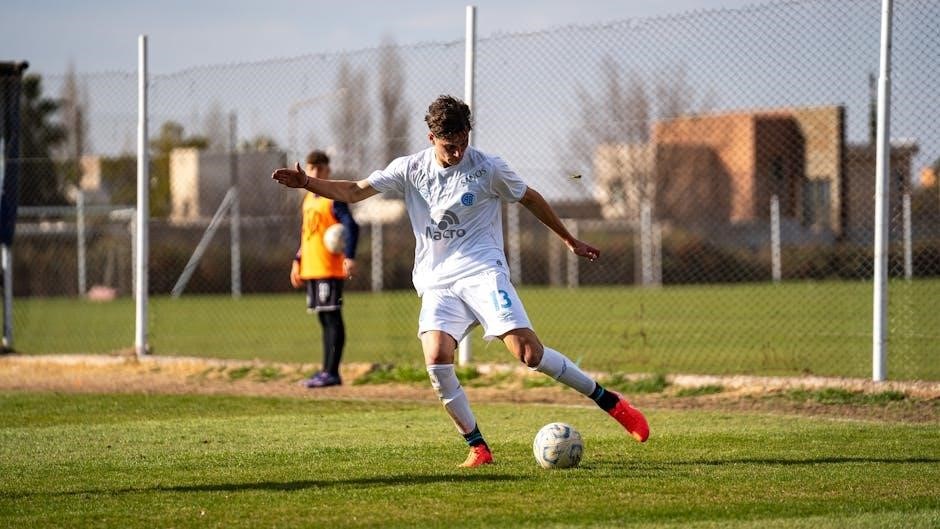
Structured Practice Plans
Structured plans optimize training efficiency, ensuring progressive skill development through clear objectives and adaptable drills. They keep sessions engaging while addressing player needs and skill levels effectively.
Sample Practice Sessions
Sample practice sessions provide coaches with detailed, ready-to-use plans, covering warm-ups, skill drills, and game-like scenarios. These sessions are designed to improve technical, tactical, and physical abilities. They include drills for dribbling, passing, shooting, and defense, as well as fitness exercises like agility ladder workouts and small-sided games. Each session is structured to adapt to different skill levels, ensuring players stay engaged and challenged. Coaches can follow these plans to create balanced and productive training environments, helping teams progress effectively throughout the season.
Progressive Skill Development
Progressive skill development ensures players build a strong foundation before advancing to more complex drills. Coaches start with basic techniques like ball control and gradually introduce game-like challenges. This structured approach enhances technical, tactical, and physical abilities, allowing players to adapt to increasing demands. By integrating varied exercises and adapting drills to player progress, coaches can foster continuous improvement and prepare teams for competitive play effectively. This method keeps practices engaging and ensures steady growth throughout the season.
Adapting Drills to Skill Levels
Adapting drills to skill levels ensures every player benefits from practice. Coaches can modify exercises by adjusting difficulty, adding defenders, or incorporating game-like scenarios. For younger or less experienced players, focus on foundational skills like dribbling and passing. As players progress, introduce more complex drills that challenge their abilities. Incorporating feedback and observing player development allows coaches to tailor activities effectively. This approach ensures drills remain engaging, educational, and suited to the team’s needs, fostering growth and enjoyment for all players involved.
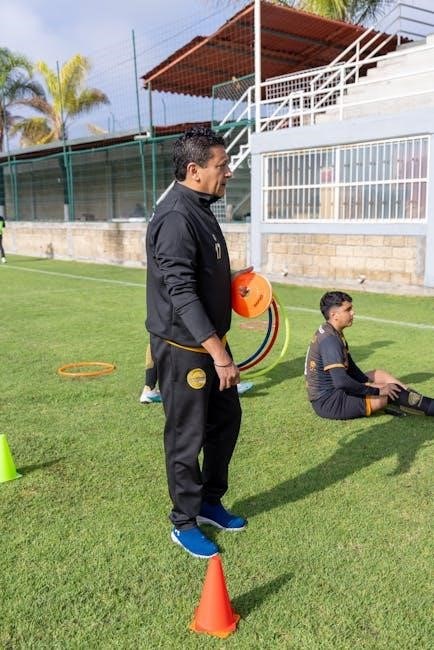
Selecting the Right Drills
Selecting the right drills involves matching exercises to player age, skill, and specific needs. Ensure drills are engaging, challenging, and balanced between skill-focused and game-like activities for optimal development.
Matching Drills to Player Age and Skill
Drills should be tailored to players’ age, skill level, and specific needs. Start with foundational skills for younger or less experienced players, such as basic dribbling and passing exercises. As players progress, introduce more complex drills like cone weaving or game-like scenarios. Ensure activities are engaging and challenging, balancing technical development with fun. This approach fosters growth, keeps players motivated, and ensures drills are relevant to their developmental stage, promoting a well-rounded skill set and long-term improvement.
Ensuring Fun and Engagement
Keeping practices engaging is key to maintaining player motivation and enjoyment. Incorporate interactive games like soccer tennis or small-sided matches to add excitement. Vary drills to avoid repetition and include activities that promote teamwork and camaraderie. Positive reinforcement and encouragement from coaches help build confidence. Allow players to explore creativity and try new skills in a supportive environment. Balancing structure with fun ensures players stay focused and eager to improve, making each session productive and enjoyable for everyone involved. This approach fosters a love for the game while developing skills effectively.
Incorporating Teamwork and Real-Game Scenarios
Incorporate drills that mimic real-game situations to enhance teamwork and decision-making. Small-sided games and 4-on-3 scenarios encourage players to work together and adapt to dynamic conditions. Activities like “Space Wars” foster competition and problem-solving, preparing players for match-like intensity. These exercises improve communication, tactical awareness, and the ability to execute strategies under pressure. By simulating game scenarios, players develop the instincts and coordination needed for cohesive team play, making practices both challenging and rewarding.
